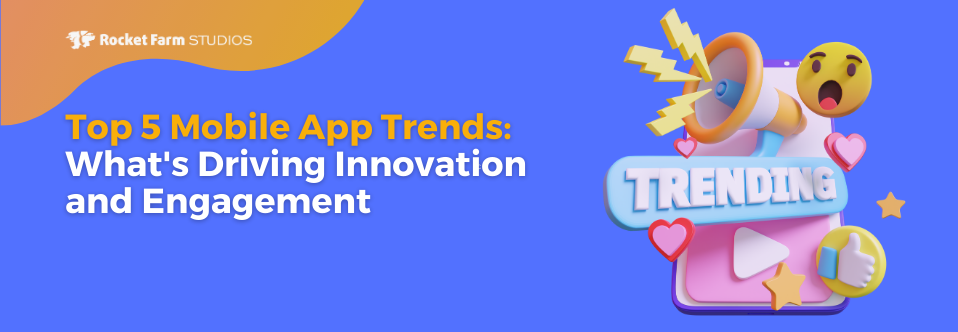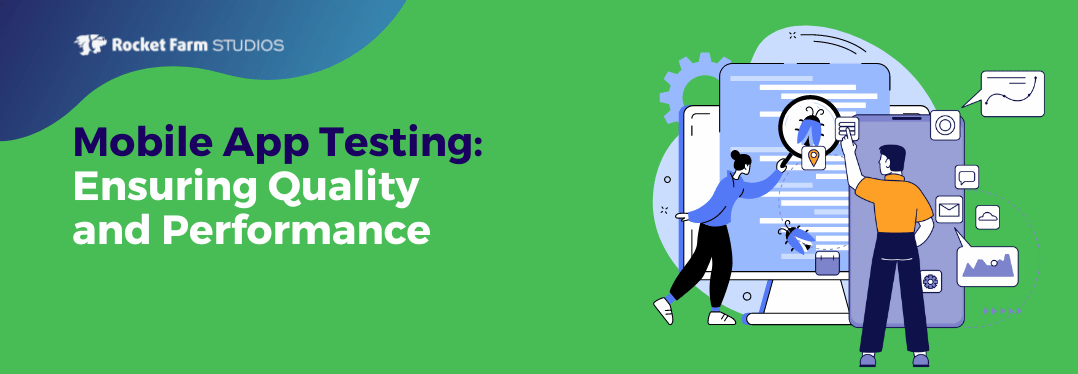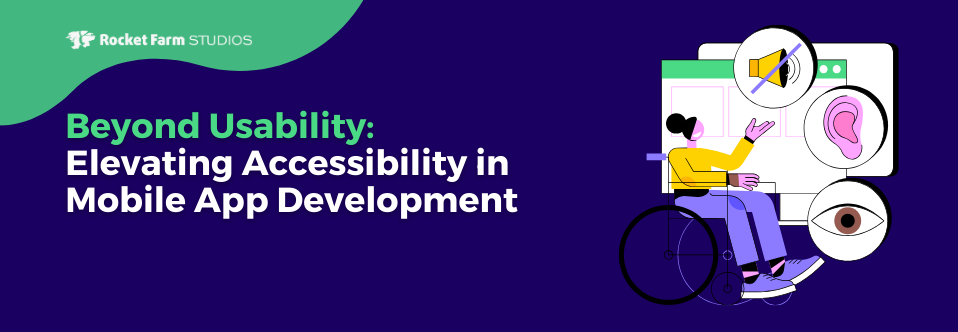Over the past 5 years, the world of mobile app development has witnessed remarkable milestones and transformative advancements. We’ve seen mobile app trends, from the rise of Augmented Reality (AR) and the integration of Artificial Intelligence (AI) to the adoption of Progressive Web Apps (PWAs) and enhanced security measures, this period has been marked by rapid technological evolution. The rollout of 5G networks, the integration of Internet of Things (IoT) devices, and the emergence of beacon technology for location-based services have reshaped the mobile app landscape.
Additionally, blockchain applications, the evolution of mobile commerce, and the utilization of predictive analytics for user engagement have all played pivotal roles in enhancing the capabilities and engagement potential of mobile apps. These milestones reflect a dynamic journey that continues to redefine user experiences and push the boundaries of mobile app innovation.
Simply put, there’s a lot of trends to pay attention to!
In this blog, we delve into the dynamic landscape of mobile app development, highlighting the top 5 mobile app trends that Rocket Farm Studios considers instrumental in driving innovation and enhancing user engagement. These trends encompass practical approaches and technologies that can significantly elevate the success of your mobile app.
Whether you’re a seasoned developer or a visionary entrepreneur embarking on a mobile app venture, understanding these milestones and trends will equip you with invaluable insights and strategies to create apps that captivate, serve, and retain users effectively.
1. Artificial Intelligence (AI)
Artificial Intelligence (AI) has ushered in a new era of mobile app capabilities, where apps not only respond to but also adapt intelligently to user needs and preferences. AI empowers mobile apps to think, learn, and make informed decisions, paving the way for highly personalized and engaging experiences.
Personalized Content Delivery
In the realm of content delivery, streaming apps utilize AI algorithms to curate personalized recommendations based on users’ viewing history and preferences. This level of personalization ensures that users are presented with content that aligns with their tastes, leading to longer engagement and increased user satisfaction.
Voice Recognition
Voice recognition, exemplified by virtual assistants like Siri and Google Assistant, has become a staple feature in modern mobile devices. These AI-driven voice interfaces enable users to interact with their devices naturally, providing information, setting reminders, or even initiating actions within apps through voice commands. This hands-free interaction not only enhances user convenience but also fosters a deeper level of engagement. NLP (Natural Language Processing) advancements from various companies are rapidly propelling voice recognition towards truly conversational interfaces.
Conversational Interfaces
An example of such innovation is the Rabbit.tech R1 product, which is powered by modern NLP technologies that significantly surpass Siri’s capabilities. Moreover, Apple’s recent announcement of Ferret From Siri to Ferret: The Next Chapter in AI Conversations underscores the ongoing evolution and enhancement of AI-driven conversational interfaces. These developments indicate a significant leap forward in making voice recognition technology more intuitive and interactive, aligning with the user’s natural mode of communication.
Predictive Text Input
Predictive text input, another facet of AI, anticipates and suggests words or phrases as users type, streamlining text entry and reducing errors. This predictive capability enhances the speed and accuracy of user interactions, whether it’s composing messages, conducting searches, or filling out forms.
AI-powered Chatbots and Virtual Assistants
Moreover, the emergence of AI-powered chatbots and virtual assistants, like ChatGPT and others, has revolutionized customer support and user engagement. These chatbots offer instant responses to user inquiries, provide product recommendations, and offer guidance, all in a conversational manner. Users can access assistance 24/7, leading to higher levels of user satisfaction and prolonged app engagement.
The Impact of AI on Mobile Apps
AI changes everything. It is a revolutionary change in how products are produced, and what you can do with them. AI has become the driving force behind mobile app personalization and intelligent decision-making. Whether through tailored content recommendations, voice recognition, predictive text input, or AI-powered chatbots, it’s AI’s ability to understand and cater to individual user needs that significantly enhances user engagement within mobile apps.
2. Augmented Reality (AR)
Augmented Reality (AR) represents a groundbreaking technological advancement that seamlessly merges the digital and physical realms within the confines of a mobile device. AR applications harness the power of a device’s camera to superimpose digital elements onto the real world, giving rise to captivating and interactive experiences that transcend the ordinary.
Transforming Retail and Shopping
This transformative technology has extended its reach far beyond the realm of gaming, finding applications in diverse industries. For instance, furniture retailers have harnessed AR’s potential to revolutionize the way customers shop for home furnishings. Shoppers can use AR apps to visualize how a new sofa or coffee table would fit and look in their living room before making a purchase. This not only enhances the shopping experience but also mitigates the uncertainty often associated with online furniture shopping.
Impact on the AR and VR Market
Meta’s Quest line of VR headsets, including the recently launched Quest 3, has significantly impacted the AR and VR market. By the end of 2023, Meta reported nearly 20 million Quest headsets sold, with record sales of around $1.07 billion in the fourth quarter alone, following the Quest 3’s launch. This milestone underscores the widespread consumer interest in immersive technologies and highlights the shift towards new paradigms of digital interaction beyond traditional smartphone apps
Revolutionizing Education
In the realm of education, AR has emerged as a powerhouse, transforming traditional textbooks into immersive learning experiences. Educational apps now offer students the opportunity to interact with 3D models of historical artifacts, dissect virtual biology specimens, or explore the cosmos through their smartphone screens. AR makes learning engaging and interactive, fostering a deeper understanding of complex subjects and enhancing knowledge retention.
Applications Beyond Shopping and Education
Beyond shopping and education, AR continues to bridge the gap between reality and digital innovation across a spectrum of domains. It empowers architects and interior designers to create virtual walkthroughs of architectural designs, allowing clients to experience spaces before construction begins. In the healthcare sector, AR assists surgeons with visualizing complex medical procedures in real-time, enhancing precision and safety.
The Transformative Force of AR
In summary, Augmented Reality (AR) is not merely a technological novelty; it is a transformative force that revolutionizes user engagement across a myriad of industries. By seamlessly integrating digital elements into the physical world, AR offers immersive experiences that enrich shopping, education, design, and countless other domains, making it an invaluable tool for enhancing user engagement and interaction.

3. Beacon Technology
Beacon technology represents a fascinating dimension of mobile app innovation, where the physical and digital worlds harmoniously converge to create highly personalized user experiences. At its core, beacon technology operates by leveraging small, unobtrusive devices called beacons that transmit Bluetooth signals to nearby smartphones and other smart devices.
Context-Aware Interactions
These signals, when detected by compatible mobile apps, enable context-aware interactions and content delivery, thereby elevating user engagement to new heights. One of the hallmark features of beacon technology is its ability to respond to users’ physical proximity to specific locations or objects.
Transforming Retail Experiences
By strategically placing beacons in physical spaces such as retail stores, museums, stadiums, or airports, mobile apps can detect a user’s presence and offer contextually relevant content, promotions, or information precisely when and where it matters most. In retail, for instance, beacon technology has revolutionized the in-store shopping experience. Retail apps equipped with beacon compatibility can greet shoppers with personalized messages or offers as they enter a store. As users move through the store, beacons can trigger notifications about nearby products, provide price comparisons, or offer discounts on items of interest.
This level of personalized engagement not only enhances the shopping experience but also fosters a sense of connection between users and the brand.
Enhancing Museum Visits
Museums and cultural institutions have also embraced beacon technology to transform how visitors engage with exhibits. As users explore a museum, beacons can deliver rich multimedia content, historical context, or interactive challenges related to specific artworks or artifacts. This immersive approach to learning fosters deeper engagement and a more profound appreciation of the subject matter.
Broad Sector Application
The versatility of beacon technology extends to various sectors, including hospitality, sports, and events. In hotels, guests can receive digital room keys upon arrival, while sports venues can provide fans with real-time updates, seat upgrades, or concession stand discounts based on their proximity to various points of interest.
The Potential of Beacons
Much like the QR code, which took its time to become a staple in connecting people to businesses or each other, beacon technology is on a similar trajectory. Initially slow to catch on, beacons are gradually becoming more integrated into our daily lives, particularly with advancements like ultra-wideband (UWB) and their incorporation into smart city projects.
This blend of technology and physical environments is setting the stage for beacons to revolutionize personalized engagement, offering tailored content and interactions that merge seamlessly with our real-world experiences.
As beacon technology evolves, it’s poised to significantly enhance our interaction with the physical world via mobile devices, signaling a future where it’s as omnipresent and useful as the QR code has become.
Keep an eye on beacons; they have the potential to be everywhere!
4. Mobile Learning (mLearning)
Mobile Learning, often referred to as mLearning, has emerged as a revolutionary approach to education and skill development. It empowers users to consume educational content on mobile devices at their own pace, offering a flexible and engaging learning experience that enhances knowledge retention.
Flexibility and Accessibility
One of the key advantages of mLearning is its flexibility. Users can access educational content anytime, anywhere, making learning a seamless part of their daily lives. Whether it’s brushing up on a new language during a commute or diving into a new skill while waiting for an appointment, mLearning caters to the individual’s schedule and preferences.
Success Stories in mLearning
Apps like Duolingo serve as prime examples of mLearning’s success. Duolingo allows users to learn a new language through bite-sized lessons, interactive exercises, and gamified challenges. Users can progress through lessons at their own pace, earning rewards and tracking their progress along the way. The app’s engaging approach to language learning has made it a popular choice for millions of users worldwide, demonstrating the effectiveness of mLearning in delivering educational content.
Diverse Content Formats
Furthermore, mLearning offers a diverse range of content formats, from video lessons and quizzes to interactive simulations and augmented reality experiences. This variety ensures that learners can engage with content in ways that resonate with their individual learning styles, promoting deeper understanding and retention of information.
Gamification in mLearning
Incorporating elements of gamification, mLearning apps often use achievements, badges, and leaderboards to motivate and engage users. These gamified features transform learning into an enjoyable and competitive experience, further enhancing user engagement and progression.
The Role of AI in mLearning
In summary, Mobile Learning (mLearning) empowers users to take control of their education by providing access to educational content on mobile devices. Its flexibility, diverse content formats, and gamified elements make it an effective tool for boosting engagement and knowledge retention. Moreover, AI plays a crucial role in this ecosystem, significantly contributing to mass personalization by tailoring learning experiences to meet the specific needs of each user. Apps like Duolingo exemplify how mLearning, augmented by AI, can revolutionize learning experiences, catering to the modern learner’s preferences and requirements.

5. Predictive Analytics
Predictive analytics has emerged as a powerful tool in mobile app development, enabling developers to gain valuable insights into user behavior and preferences. By analyzing past user interactions and data, predictive analytics can forecast the optimal moments for various app engagements, ultimately enhancing user engagement by delivering content when users are most receptive.
AI’s Role in Enhancing Predictive Analytics
And here’s another place where AI is enabling massive change in what’s possible: through its integration into predictive analytics, AI is revolutionizing how developers understand and interact with their user base, making personalized and timely engagement not just a goal, but a reality.
Optimizing Notification Timing
One of the primary applications of predictive analytics is in determining the ideal timing for sending notifications. By studying user patterns and historical data, mobile apps can predict when users are most likely to engage with their devices. This knowledge allows apps to send notifications strategically, ensuring that users receive them at moments when they are likely to be attentive and responsive. For example, a news app might send a morning briefing notification to users who typically check the news before starting their day, increasing the chances of user interaction and engagement.
Personalized Content Delivery
Moreover, predictive analytics plays a pivotal role in personalized content delivery. By understanding user preferences, app algorithms can curate and deliver content that aligns with individual tastes. For instance, a video streaming app might use predictive analytics to recommend movies or shows based on a user’s past viewing habits, leading to a more satisfying and engaging user experience.
Enhancing In-App Messages
In-app messages, another engagement tool, can also benefit from predictive analytics. Apps can anticipate when users are active and most likely to engage with in-app messages, ensuring that important announcements, promotions, or updates are delivered when they are most likely to be seen and acted upon.
Predictive analytics leverages historical user data to predict the optimal moments for app interactions, such as notifications, content delivery, and in-app messages. This strategic approach to engagement enhances user satisfaction by ensuring that content is delivered when users are most receptive, ultimately leading to higher levels of user engagement and retention.

Final Thoughts
Amid this ever-shifting landscape, one fact has become resoundingly clear: adaptability is not merely valuable; it is an essential skill for developers and entrepreneurs alike. The ability to identify emerging mobile app trends, assess their relevance, and seamlessly incorporate them into mobile app strategies can be the determining factor between achieving success and fading into obscurity. Adapting to change isn’t just a choice; it’s an absolute necessity in an industry that thrives on continuous innovation.
The mobile app industry is in a constant state of evolution, and the horizon promises even more thrilling developments. Staying well-informed about the latest trends and forging partnerships with industry experts are your means to positioning your mobile app for success in this ever-changing environment. The journey doesn’t conclude here; it’s an ongoing exploration of new possibilities and user experiences that holds the potential for limitless growth.
At Rocket Farm Studios, we’re tearing up the rule books to help our clients harness the power of AI. From building new product ideas faster with AI-based business models, we’re changing the way we do things rapidly to stay at the forefront of these trends. Our commitment to innovation and excellence ensures that your mobile app will not only meet the current demands of the market but also anticipate future trends, keeping you ahead in the dynamic world of mobile technology.








